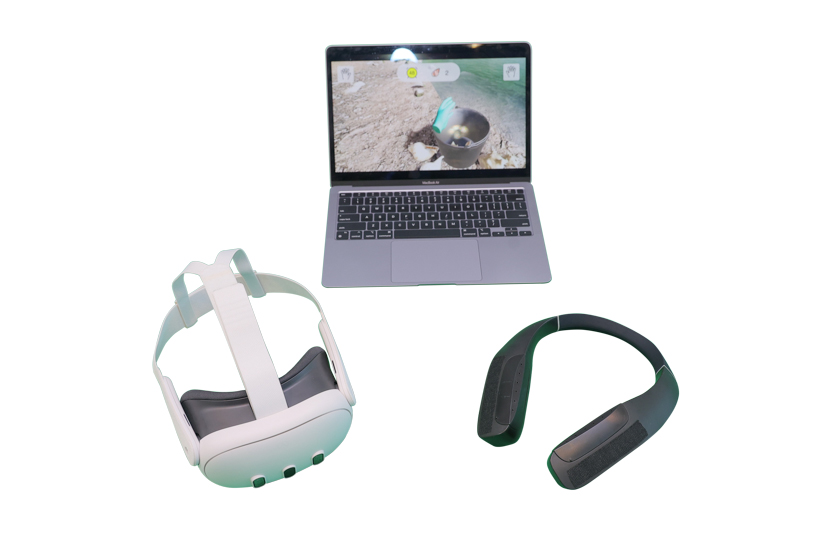User Pain Points
該計畫解決了老年人和有心理健康問題的人面臨的挑戰,包括難以獲得透過嗅覺刺激進行體力活動、認知訓練和心理健康的綜合多感官治療。這些用戶的痛點包括難以獲得全面的多感官治療方案:包括針對身體活動、認知訓練和心理健康的嗅覺刺激治療。一般社區的老年用戶缺乏長期服務的設備和平台。這些可以透過此方案及人工智慧應用程式來解決。從護理人員的角度來看,該項目減少管理工作並節省時間,同時也提供了包括運動追蹤在內的即時遠端監控系統,並提供一體化解決方案,增強了可訪問性,提供全面的支持,並改善了主要使用者和護理人員的維護成本。
Solution Benefits
使用者可以從全方位的訓練中獲益,這些訓練包括與文化相關的活動,他們可以透過在家進行的定期訓練來積極參與並提供便利性。它提供一個安全且受控的環境,隨時隨地都可使用。提供個性化的訓練以滿足個人需求,並進行長期數據追蹤和調整。該解決方案適用於廣泛的人群,包括健康的老年人、心理健康問題人士以及住院和門診患者。此外,它還可以通過遠程康復使一位專家可以協助多個使用者,促進高效且易於接觸的護理。這些功能提升使用者體驗,並為社區的福祉做出貢獻。
Technologies Applied
這是一款創新且全面的一體化應用程序,結合了 VR 技術、多感官刺激(包括嗅覺元素)、AI 演算法、運動追蹤、遠端復健、雲端運算和遊戲化。它讓使用者沉浸在引人入勝的虛擬環境中,而多感官刺激則增強了治療潛力。旨在增強身體活動、認知訓練和心理健康。它提供了一系列模組,包括嗅覺多感官方法、個人化人工智慧生成的功能以及 IADL 任務、園藝活動和自然療法等治療內容。 這方案利用機器學習和運動追蹤等尖端技術來提供客製化體驗和自適應馬達控制功能。憑藉跨平台相容性,它可以透過頸掛式嗅覺裝置、VR 或基於螢幕的裝置進行存取。遊戲化創造了引人入勝且激勵人心的體驗。該應用程式提供了一種突破性的方法,旨在簡化醫療保健、改善福祉並滿足用戶(包括老齡化人口)的多樣化需求。
Target Users
User Profile / Persona:
Age Group:
Primarily elderly(65+), Some middle-aged adults(40-64)
Occupation:
Mostly retired. Some still working part-time/volunteering
Psychographics:
a) Values health and well-being
b) Seeks to maintain independence
c) Interested in non-pharmacological therapies
d) May feel isolated/disconnected
e) Desires mental stimulation and engagement
f) Open to trying new technologies with support
g) May have limited mobility/sensory capabilities
h) Seeks activities that improve quality of life
Living Situation:
a) Independent living
b) Assisted living facilities
c) Nursing homes
d) With family caregivers
Health Status:
a) Managing chronic conditions
b) Recovering from injuries/surgeries
c) Dealing with age-related decline
d) Coping with mental health challenges
User Scenario and Goals:
Users engage with multisensory technology across various settings, from private homes to healthcare facilities. They participate in immersive experiences tailored to their needs, including virtual cognitive and physical therapy, and relaxation programs. It aims to enhance mental acuity, improve physical function, reduce stress, and increase social engagement. It offers personalized, adaptive interventions in safe, controlled environments. Users seek to maintain independence, enhance motor and cognitive functions, stimulate neural plasticity, and improve well-being. The system tracks progress, allowing for continual adjustment of treatment plans. Ultimately, it provides an accessible, engaging alternative to traditional therapies, enhancing quality of life for diverse users.

